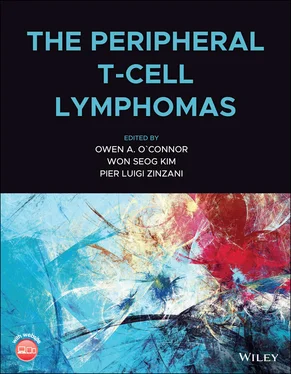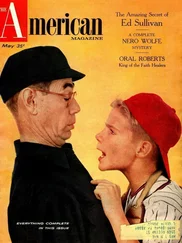The majority of mature T‐cell neoplasms are derived from alpha‐beta T cells that normally comprise CD4+ (mainly helper) and CD8+ (mainly cytotoxic) subsets, and tend to involve primarily lymph nodes. The discovery that the clonal T cells of AITL a shared the gene expression profile and immunophenotype of normal Tfh cells, represented a major step forward in the deciphering of the neoplastic to normal cell counterpart relatedness of mature nodal T‐cell lymphomas [61]. This important notion is now incorporated in the definition of the disease and in the current classification scheme, where cellular derivation from Tfh cells is the defining feature of a large group of mature CD4+ T cells. Importantly, this group of diseases defined by a common immunophenotype appears to be associated with clinical features reflecting the functional properties of the neoplastic cells and have in common a characteristic mutational landscape resulting in epigenetic deregulation and activation of receptor signaling pathways [112, 117]. Subsequently, unsupervised analysis of genome‐wide molecular profiles identified two distinct molecular subgroups of PTCL‐NOS, defined by the overexpression of GATA3 or TBX21 (t‐bet) and associated target genes. GATA3 and TBX21 are master regulators of gene expression profiles in Th cells skewing Th polarization into Th2 and Th1 differentiation pathways, respectively, suggesting that a large proportion of PTCL, NOS are related to either Th1 or Th2 lineage derivation. Moreover, both subgroups tend to correlate with different prognoses, and are associated with distinct structural genomic alterations and point mutations [6]. The neoplastic cells in HTLV1‐associated T‐cell lymphoma/leukemia often exhibit a T‐regulatory phenotype with frequent expression of FOXP3 transcription factor.
The notion of cellular derivation and normal cell counterpart has often been used interchangeably, implying that the driver oncogenic mutation target distinct subsets of mature T cells. This concept was recently challenged by novel data, which have highlighted a more complex picture. In the case of so‐called “lymphomas derived from Tfh cells,” experimental data and observations in humans have clearly demonstrated that, while early mutations in epigenetic modifiers may occur in early hematopoietic progenitors ahead of the lymphoid versus myeloid commitment, second‐line mutations occur in such primed cells engaged in the lymphoid lineage and are responsible for driving the Tfh differentiation of the neoplastic cells [118]. Hence, Tfh cells are better viewed as the normal cell counterpart, rather than the cell of origin. In the case of ALK‐positive ALCL, experimental data in a mouse model have suggested that it may arise in progenitor cells [119]. In ATLL associated with HTLV1 infection, expression of the Treg immune profile (positivity for CCR4 chemokine receptor and nuclear FoxP3) found in a subset of the cases [120], has led to the suggestion that ATLL may derive from Treg cells. However, some cases may express CD8 or lose CD4 expression, and it has been shown that FoxP3 is induced by HBZ, and the Treg phenotype can be induced by FoxP3 [121]; thus ATLL does not necessarily originate from Treg cells.
Molecular analysis has shed light on the diversity and hierarchy of genetic events linked to T
LdL is supported by a grant of the Swiss National Foundation.
Heavican, T.B., Bouska, A., Yu,. J, et al. (2019). Genetic drivers of oncogenic pathways in molecular subgroups of peripheral T‐cell lymphoma. Blood 133(15):1664–1676.
Lemonnier, F., Couronné, L., Parrens, M., et al. (2012). Recurrent TET2 mutations in peripheral T‐cell lymphomas correlate with TFH‐like features and adverse clinical parameters. Blood 120(7):1466–1469.
Sakata‐Yanagimoto, M., Enami, T., Yoshida, K. et al. (2014). Somatic RHOA mutation in angioimmunoblastic T cell lymphoma. Nat Genet 46(2):171–175.
Crescenzo, R., Abate, F., Lasorsa, E. et al. (2015). Convergent mutations and kinase fusions lead to oncogenic STAT3 activation in anaplastic large cell lymphoma. Cancer Cell 27(4):516–532.
Gaulard, P., de Leval, L. (2014). The microenvironment in T‐cell lymphomas: emerging themes. Semin Cancer Biol 24:49–60.
1 1 Morris, S.W., Kirstein, M.N., Valentine, M.B. et al. (1994). Fusion of a kinase gene, ALK, to a nucleolar protein gene, NPM, in non‐Hodgkin's lymphoma. Science 263 (5151): 1281–1284.
2 2 Parrilla Castellar, E.R., Jaffe, E.S., Said, J.W. et al. (2014). ALK‐negative anaplastic large cell lymphoma is a genetically heterogeneous disease with widely disparate clinical outcomes. Blood 124 (9): 1473–1480.
3 3 Abate, F., da Silva‐Almeida, A.C., Zairs, S. et al. (2017). Activating mutations and translocations in the guanine exchange factor VAV1 in peripheral T‐cell lymphomas. Proc Natl Acad Sci U S A 114 (4): 764–769.
4 4 Yoo, H.Y., Sung, M.K., Lee, S.H. et al. (2014). A recurrent inactivating mutation in RHOA GTPase in angioimmunoblastic T cell lymphoma. Nat Genet 46 (4): 371–375.
5 5 Vallois, D., Dupuy, A., Lemonnier, F. et al. (2018). RNA fusions involving CD28 are rare in peripheral T‐cell lymphomas and concentrate mainly in those derived from follicular helper T cells. Haematologica 103 (8): e360–e363.
6 6 Heavican, T.B., Bouska, A., Yu, J. et al. (2019). Genetic drivers of oncogenic pathways in molecular subgroups of peripheral T‐cell lymphoma. Blood 133 (15): 1664–1676.
7 7 Stephens, P.J., Greenman, C.D., Fu, B. et al. (2011). Massive genomic rearrangement acquired in a single catastrophic event during cancer development. Cell 144 (1): 27.
8 8 Boddicker, R.L., Razidlo, G.L., Dasari, S. et al. (2016). Integrated mate‐pair and RNA sequencing identifies novel, targetable gene fusions in peripheral T‐cell lymphoma. Blood 128 (9): 1234–1245.
9 9 Kataoka, K., Shiraishi, Y., Takeda, Y. et al. (2016). Aberrant PD‐L1 expression through 3’‐UTR disruption in multiple cancers. Nature 534 (7607): 402–406.
10 10 Kataoka, K., Miyoshi, H., Sakata, S. et al. (2019). Frequent structural variations involving programmed death ligands in Epstein‐Barr virus‐associated lymphomas. Leukemia 33 (7): 1687–1699.
11 11 Liu, C., Iqbal, J., Teruya‐Feldstein, J. et al. (2013). MicroRNA expression profiling identifies molecular signatures associated with anaplastic large cell lymphoma. Blood 122 (12): 2083–2092.
12 12 Valleron, W., Ysebaert, L., Berquet, L. et al. (2012). Small nucleolar RNA expression profiling identifies potential prognostic markers in peripheral T‐cell lymphoma. Blood 120 (19): 3997–4005.
13 13 Wang, L., Ni, X., Covington, K.R. et al. (2015). Genomic profiling of Sezary syndrome identifies alterations of key T cell signaling and differentiation genes. Nat Genet 47 (12): 1426–1434.
14 14 Sakata‐Yanagimoto, M., Enami, T., Yoshida, K. et al. (2014). Somatic RHOA mutation in angioimmunoblastic T cell lymphoma. Nat Genet 46 (2): 171–175.
15 15 Odejide, O., Weigert, O., Lane, A.A. et al. (2014). A targeted mutational landscape of angioimmunoblastic T‐cell lymphoma. Blood 123 (9): 1293–1296.
16 16 Lemonnier, F., Couronné, L., Parrens, M. et al. (2012). Recurrent TET2 mutations in peripheral T‐cell lymphomas correlate with TFH‐like features and adverse clinical parameters. Blood 120 (7): 1466–1469.
17 17 Couronné, L., Bastard, C., and Bernard, O.A. (2012). TET2 and DNMT3A mutations in human T‐cell lymphoma. N Engl J Med 366 (1): 95–96.
18 18 Cairns, R.A., Iqbal, J., Lemonnier, F. et al. (2012). IDH2 mutations are frequent in angioimmunoblastic T‐cell lymphoma. Blood 119 (8): 1901–1903.
Читать дальше












